The Intel Ivy Bridge (Core i7 3770K) Review
by Anand Lal Shimpi & Ryan Smith on April 23, 2012 12:03 PM EST- Posted in
- CPUs
- Intel
- Ivy Bridge
The Test
It turns out that our initial preview numbers were quite good. The shipping 3770K performs identically to what we tested last month. To keep the review length manageable we're presenting a subset of our results here. For all benchmark results and even more comparisons be sure to use our performance comparison tool: Bench.
| Motherboard: | ASUS P8Z68-V Pro (Intel Z68) ASUS Crosshair V Formula (AMD 990FX) Intel DX79SI (Intel X79) Intel DZ77GA-70K (Intel Z77) |
| Hard Disk: | Intel X25-M SSD (80GB) Crucial RealSSD C300 OCZ Agility 3 (240GB) |
| Memory: | 4 x 4GB G.Skill Ripjaws X DDR3-1600 9-9-9-20 |
| Video Card: | ATI Radeon HD 5870 (Windows 7) AMD Processor Graphics Intel Processor Graphics |
| Video Drivers: | AMD Catalyst 12.3 |
| Desktop Resolution: | 1920 x 1200 |
| OS: | Windows 7 x64 |
General Performance
SYSMark 2007 & 2012
Although not the best indication of overall system performance, the SYSMark suites do give us a good idea of lighter workloads than we're used to testing. SYSMark 2007 is a better indication of low thread count performance, although 2012 isn't tremendously better in that regard.
As the SYSMark suites aren't particularly thread heavy, there's little advantage to the 6-core Sandy Bridge E CPUs. The 3770K however manages to slot in above all of the other Sandy Bridge parts at between 5—20% faster than the 2600K. The biggest advantages show up in either the lightly threaded tests or in the FP heavy benchmarks. Given what we know about Ivy's enhancements, this is exactly what we'd expect.
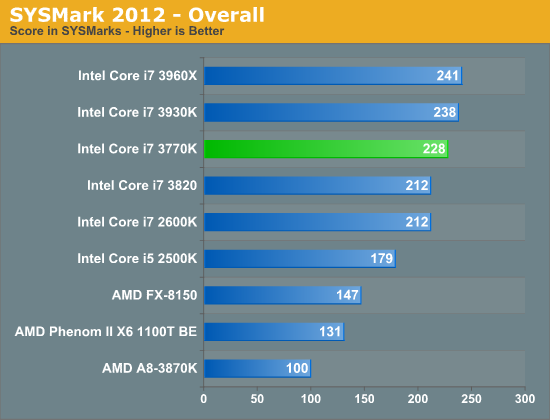
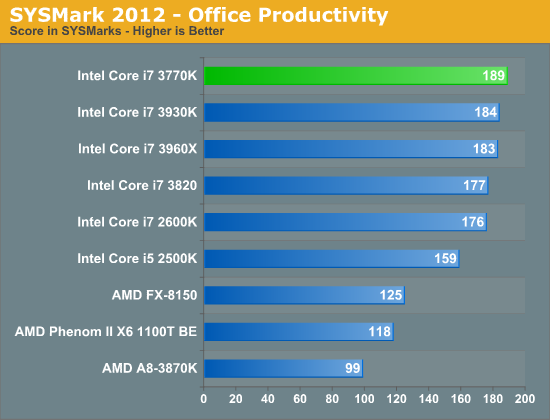

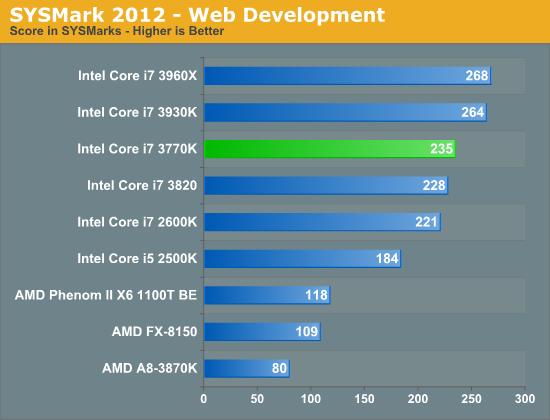
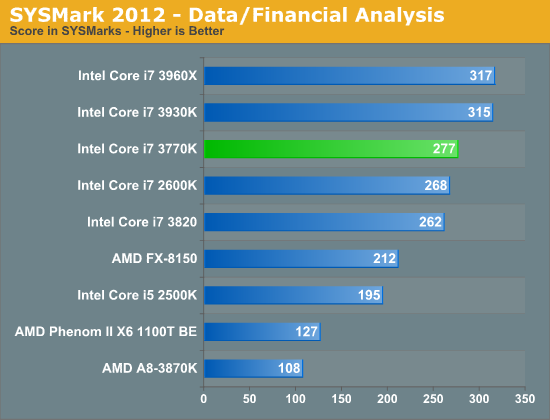
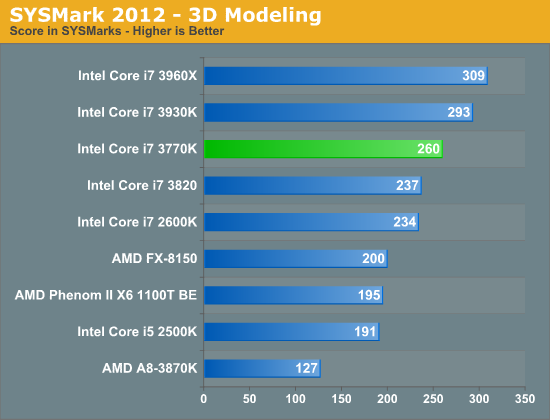


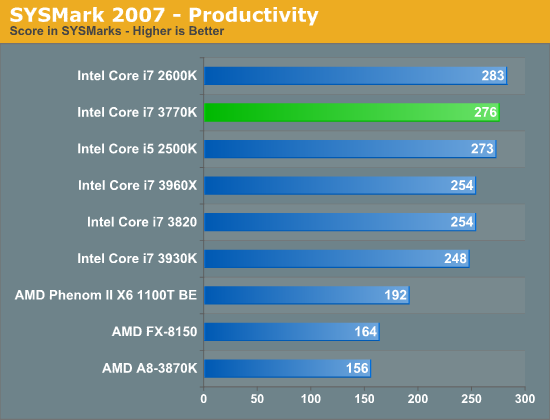
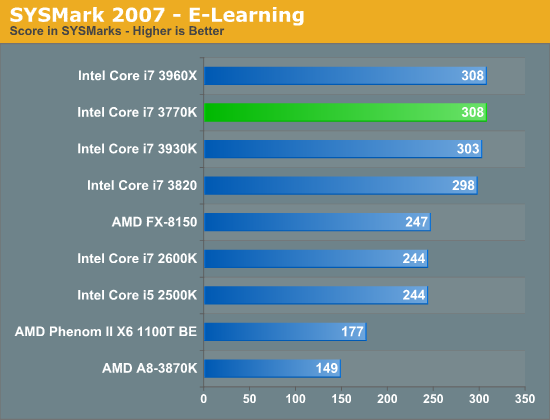
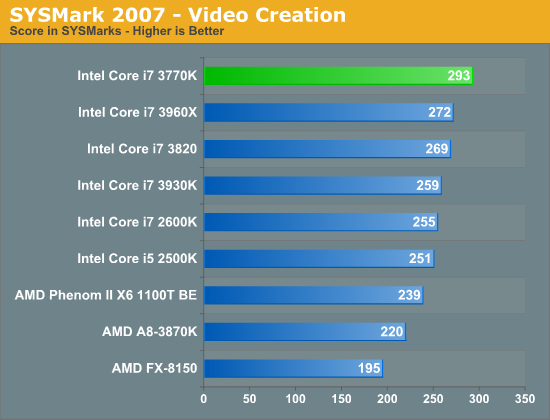

Content Creation Performance
Adobe Photoshop CS4
To measure performance under Photoshop CS4 we turn to the Retouch Artists’ Speed Test. The test does basic photo editing; there are a couple of color space conversions, many layer creations, color curve adjustment, image and canvas size adjustment, unsharp mask, and finally a gaussian blur performed on the entire image.
The whole process is timed and thanks to the use of Intel's X25-M SSD as our test bed hard drive, performance is far more predictable than back when we used to test on mechanical disks.
Time is reported in seconds and the lower numbers mean better performance. The test is multithreaded and can hit all four cores in a quad-core machine.
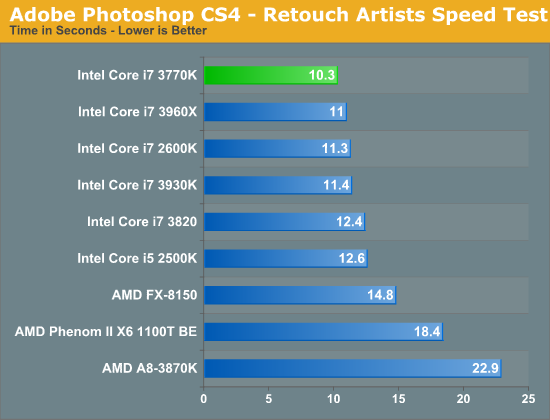
Our Photoshop test is well threaded but it doesn't peg all cores constantly. Instead you get burstier behavior. With the core count advantage out of the way, SNB-E steps aside and allows the 3770K to step up as the fastest CPU we've tested here. The performance advantage over the 2600K is around 9%.
3dsmax 9
Today's desktop processors are more than fast enough to do professional level 3D rendering at home. To look at performance under 3dsmax we ran the SPECapc 3dsmax 8 benchmark (only the CPU rendering tests) under 3dsmax 9 SP1. The results reported are the rendering composite scores.
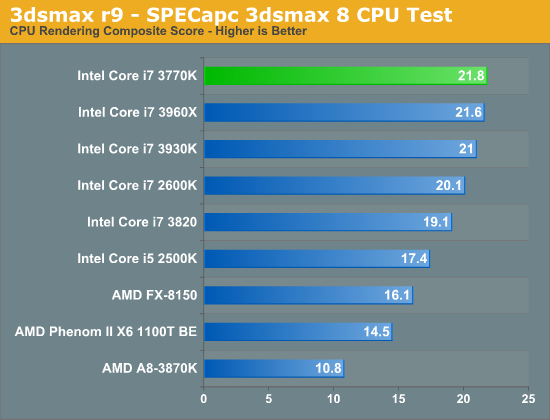
In another FP heavy workload we see a pretty reasonable gain for Ivy Bridge: 8.5% over a 2600K. This isn't enough to make you want to abandon your Sandy Bridge, but it's a good step forward for a tick.
Cinebench 11.5
Created by the Cinema 4D folks we have Cinebench, a popular 3D rendering benchmark that gives us both single and multi-threaded 3D rendering results.
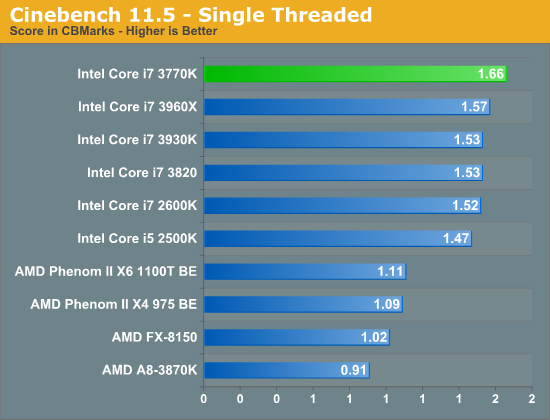
The single threaded Cinebench test shows a 9% performance advantage for the 3770K over the 2600K. The gap increases slightly to 11% as we look at the multithreaded results:
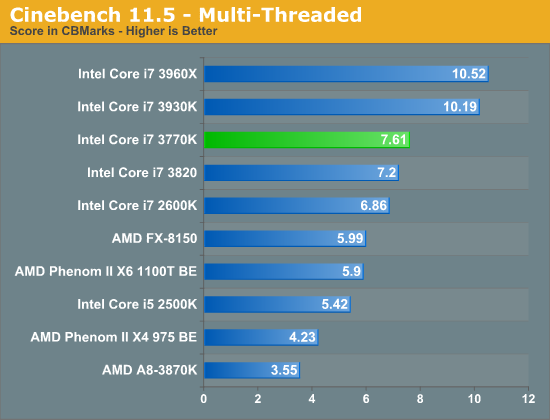
If you're running a workload that can really stress multiple cores, the 6-core Sandy Bridge E parts will remain unstoppable but in the quad-core world, Ivy Bridge leads the pack.
Video Transcoding Performance
x264 HD 3.03 Benchmark
Graysky's x264 HD test uses x264 to encode a 4Mbps 720p MPEG-2 source. The focus here is on quality rather than speed, thus the benchmark uses a 2-pass encode and reports the average frame rate in each pass.

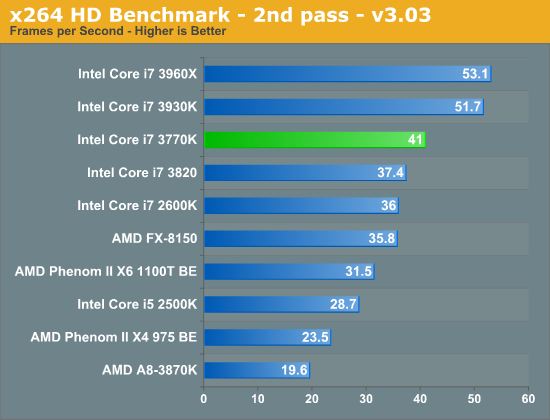
In the second pass of our x264 test we see a nearly 14% increase over the 2600K. Once again, there's no replacement for more cores in these types of workloads but delivering better performance in a lower TDP than last year's quad-core is great for more thermally conscious desktops.
Software Development Performance
Compile Chromium Test
You guys asked for it and finally I have something I feel is a good software build test. Using Visual Studio 2008 I'm compiling Chromium. It's a pretty huge project that takes over forty minutes to compile from the command line on a Core i3 2100. But the results are repeatable and the compile process will stress all 12 threads at 100% for almost the entire time on a 980X so it works for me.
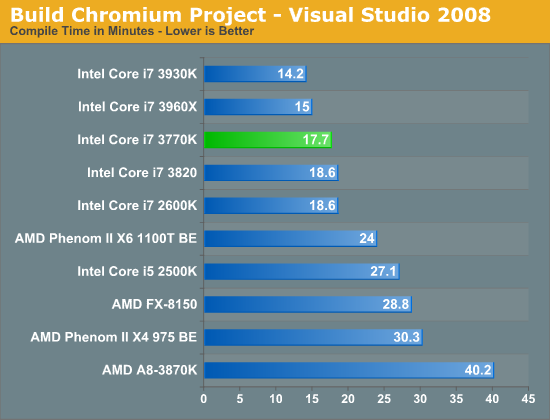
Ivy Bridge shows more traditional gains in our VS2008 benchmark—performance moves forward here by a few percent, but nothing significant. We are seeing a bit of a compressed dynamic range here for this particular compiler workload, it's quite possible that other bottlenecks are beginning to creep in as we get even faster microarchitectures.
Compression & Encryption Performance
7-Zip Benchmark
By working with a small dataset, the 7-zip benchmark gives us an indication of multithreaded integer performance without being IO limited:
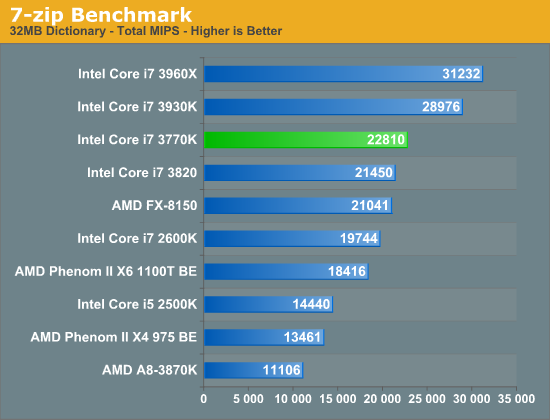
Although real world compression/decompression tests can be heavily influenced by disk IO, the CPU does play a significant role. Here we're showing a 15% increase in performance over the 2600K. In the real world you'd see something much smaller as workloads aren't always so well threaded. The results here do have implications for other heavily compute bound integer workloads however.
TrueCrypt Benchmark
TrueCrypt is a very popular encryption package that offers full AES-NI support. The application also features a built-in encryption benchmark that we can use to measure CPU performance:

Our TrueCrypt test scales fairly well with clock speed, I suspect what we're seeing here might be due in part to Ivy's ability to maintain higher multi-core turbo frequencies despite having similar max turbo frequencies to Sandy Bridge.










173 Comments
View All Comments
Shadowmaster625 - Monday, April 23, 2012 - link
I would like to start using quicksync, but 2 mbps for a tablet is way too much for me. I just want to quickly take a video and transcode it. There is nothing quick about copying a 1+ gigabyte file onto a tablet or phone. It does no good to be able to transcode faster than you can even copy it LOL. Can quicksync go lower? I want no more than 800 kbps,400-600 ideally.Also, is it possible to transcode and copy at the same time? Is anyone doing that?
BVKnight - Tuesday, April 24, 2012 - link
When you mention "2 mbps," I think you are referring to the bitrate, which is generally synonymous with the quality of the encoding."It does no good to be able to transcode faster than you can even copy" <---I think this is completely false. The transcoding is a separate file conversion step that creates the final version which you will move to your device. Your machine won't even start copying until transcoding is complete, which means that every little bit of speed you can add to the transcoding process will directly reduce the amount of time it takes to get your file on your device.
Getting quicksync will make a huge difference for your encoding.
ncrubyguy - Monday, April 23, 2012 - link
"Features like VT-d and Intel TXT are once again reserved for regular, non-K-series parts alone."Why do they keep doing that?
JarredWalton - Monday, April 23, 2012 - link
Because those are mostly for business users, and business users don't overclock and thus don't need K-series.Old_Fogie_Late_Bloomer - Monday, April 23, 2012 - link
I have a feeling that the real reason is that, if business users could get those features on a K-series processor, it would largely obviate the need/demand for SB-E. A 2600K/2700K overclocked up to, say, 4.5 GHz--which seems consistently achievable, even conservative--would compare very favorably to the 3930K, given the prices of both.Yes, I know you can overclock the 3930K, and yes, I know it has six cores and four memory controllers and more cache. But I bet that overclocked SB or IB with VT-d, &c., would make a lot of sense for a lot of applications, given price/performance considerations.
piroroadkill - Monday, April 23, 2012 - link
I'd be very interested in seeing overclocked 2500K and 2600K benchmarks tossed in, because lets be honest, one of those is the most popular CPU at the high end right now, and anyone with one has bumped it to at least 4.3GHz, often about 4.4-4.5.I think it would be nice to have a visual aid to see how that fares, but I understand the impracticality of doing so.
Rasterman - Monday, April 23, 2012 - link
Thank you for including this section, it is great. I think it would be more relevant for people though if it were a much smaller test. I think pretty much anyone is going to know that a project of that size is going to be faster with more cores and speed. What isn't so obvious though are smaller projects, where you are compiling only a few files and debugging. A typical cycle for almost all developers is: making changes, compiling, debugging to test them out. Even though you are only talking times of a few seconds, add this up to 100s-1000s of iterations per day and it makes a difference, I base my entire computer hardware selection around this workflow. For now I use the single threaded benchmarks you post as a guide.iGo - Monday, April 23, 2012 - link
The features table has put me in a great dilemma. I'm very much interested in running multiple virtual machines on my desktop, for debugging and testing purposes. Although I won't be running these virtual boxes 24x7, it would be great to have processor support for any kind of hardware acceleration that I can get, whenever I fire up these for testing. On the other hand, ability to overclock the K series processor is really tempting, and yes, a decent/modest overclock of say, 4.2-4.5GHz sounds lovely for 24x7 use.Anyone using SNB/Intel processors with VT-d can share if its worth going for non-K processor to get better virtualization performance? To be more clear, my primary job involves web-application development with UX development. For which I require a varied testing under different browsers. Currently I've setup 4 different virtual machines on my desktop with different browsers installed on different windows OS versions. Although these machines will never run 24x7 and never all at once (max 2 at once when testing). Apart from that, I also do lot of photo editing (RAW files, Lightroom and works) and bit of video editing/encoding stuff on my dekstop, mostly personal projects, rarely commercial work). Is it better to opt for 3770 for better virtual machine performance or 3770k with chance to boost overall performance by overclocking?
dcollins - Monday, April 23, 2012 - link
At the moment, VT-d will not give you any additional performance on your VM's using desktop virtualization programs like VMware workstation or Virtualbox. Neither supports VT-d right now. Based on progress this year, I expect VT-d support is still be a year away in Virtualbox, which is what I use.VT-d doesn't help performance in general; instead, VT-d allows VMs to directly access computer hardware. This is essential for high performance networking on servers or for accessing certain hardware like sound cards where low latency is crucial. For your workload, the only advantage will be slightly higher network speeds using native drivers versus a bridged connection. It may facilitate testing GPU accelerated browsers in the future as well.
If you plan on overclocking, the K series is worth loosing VT-d.
iGo - Monday, April 23, 2012 - link
Thanks, that helps a lot. I've been reading about and VT-d and your comment confirms where my thinking was going. I guess, 3770K it is then. :)